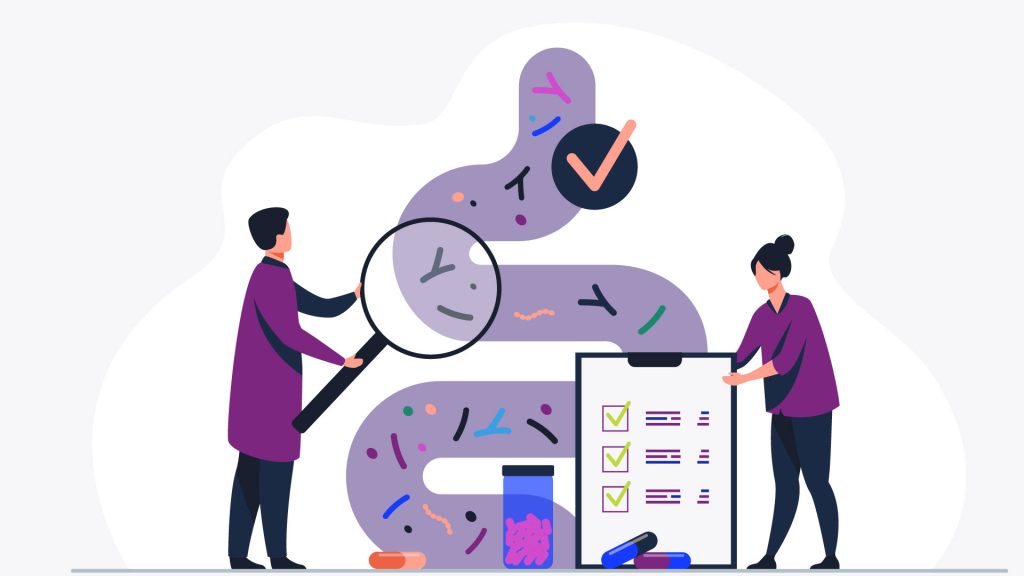Exercise & Post-lunch Gas
In a study by Villoria et al, they were able to show that mild physical activity helped participants with gassiness and abdominal pain. The researchers wanted to see if mild exercise was able to help with the movement and release of intestinal gas. Many patients with IBS have trapped intestinal gas after eating, and this could be partly responsible for the abdominal pain and bloating that they experience.
Why does gas sometimes cause us discomfort?
When we eat certain foods, sometimes our bodies can’t fully digest them, so these undigested foods become a feast for our gut microbes. The gas produced from this process can cause discomfort for many people – especially those with IBS. The amount of gas that is present in the intestines at any one time is not a straightforward process. Lots of factors are involved, including the amount of gas produced and released, how much of, or how quickly, the gas can be absorbed into the bloodstream, your microbial mix and whether they can use the gas for further processes, and lastly the complication of high-fat foods altering gas transit.
How can the effects of exercise on intestinal gas be tested?
It’s not a straightforward – or comfortable – process. We’re all very grateful to the participants for their dedication to science!
The participants were asked to avoid foods that could ferment and create intestinal gas for two days and to fast for 8 hours prior to the study. Each patient was asked to sit on an armchair, in order to avoid any effects of body position on the movement of gas. Each patient was orally and intestinally intubated (see what I mean re. dedication?). High lipid (fat) meals are known to slow gas transit and so the researchers wanted to see if exercise could help improve and promote the transit of gas after eating such a meal.
From the armchair, each patient alternated between intervals of rest and mild exercise, which involved intermittent pedaling for five-minute intervals. Throughout the entire experiment, a mix of gases was infused through the intestinal tube into the mid-portion of the colon (duodenum) and the participants were also fed a high fat meal directly into the distal/end part of the colon (jejunum). The reason for this was to see if the inhibitory effects of high fat meals on the movement of gas could be somewhat overcome by exercise. A neat thing that they used to track bloating and distension was to have the participants wear a non-stretch measuring tape-like belt during testing.
So, did exercise help?
They found that during periods of rest, the participants retained larger amounts of gas but interestingly, the pedalling improved the clearance of the gas and reduced the retention of intestinal gas. Gas retention at rest was associated with abdominal pain but this was reduced by exercise. The participants also had a distended abdomen during the testing which was related to the levels of gas retained. This was somewhat reduced during the exercise period but not significantly.
The experimental setup used in this study was tested previously with healthy individuals and they were also able to show that mild exercise promoted gas transit and helped reduce gas retention in these individuals.
So, what can we take from this?
In this study, although it was rather small (only 8 – very dedicated – subjects), the results were statistically significant, indicating that physical exercise has a positive impact on relieving excess gas and related symptoms (abdominal pain).
What can I do now?
There are many known benefits of exercise relating to different aspects of our lives. Regular exercise can improve your mental health as well as your physical health. From this study, it does seem that mild exercise may help increase the transit time of gas through your intestines, so if you suffer regularly from bloating or excess gas, why not try to incorporate exercise into your daily routine? It doesn’t have to be too strenuous, time-consuming or expensive. A 15-minute walk after lunch or even getting off at an earlier stop on your commute, are steps that you can incorporate into your life without much disruption or expense. However, If you begin to experience new or worsening bloating that is persistent, please visit your healthcare professional to discuss.



















